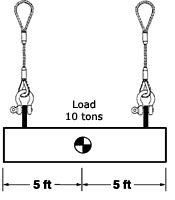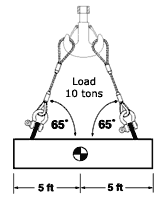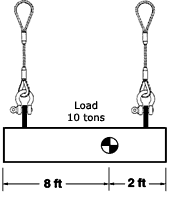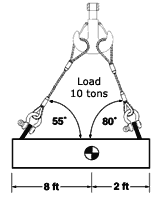Centre of Gravity (CG)
|
The location of the Centre of Gravity (CG) of the load to be lifted is a very important consideration. If the CG is not exactly centred it will affect the tension in each sling and, if the sling legs are of equal length, the load will tilt when lifted. There are many considerations and to find the exact CG is not always an easy task. |
If in doubt ask someone who knows (e.g. your safety supervisor or an engineer). Off-centre loads can severely overload your slings. The following are simplified examples of the basic considerations. |
|
 |
 |
|
| When lifted vertically the load will be shared equally if the center of gravity is placed between the pick points. If the weight of the load is 10 tones, then each sling will be subjected to a tension of 5 tones. Required is a 3/4″ diameter, 6-strand IWRC wire rope sling. |
In this example the 10 ton load is equally centred between the pick points but we lift at a sling angle of 65°. We know that each sling is subjected to 5 tons VERTICALLY. In applying the calculation from the previous section (Angularity) we arrive at: _ 10 tons _ x AF 1.103 = 5.52 tons Hence, looking up the wire rope capacity of 5.52 tons from the previous table we must use 7/8" diameter 6-strand IWRC wire rope slings. |
|
 |
 |
|
|
When the centre of gravity is not equally spaced between the pick points, the sling and fittings will not carry an equal share of the load. The sling connected to the pick point closest to the CG will carry the greatest share of the load. Sling 1 = 10 tons x 2 = 2 tons Sling 2 = 10 tons x 8 = 8 tons |
From the calculation on the left we know that sling 1 is tensioned to 2 tons, and sling 2 is tensioned to 8 tons. However both slings are on an angle, hence we must apply the angularity factor for EACH sling: Sling 1 = 2 tons x AF 1.220 (55°) = 2.44 tons Sling 2 = 8 tons x AF 1.015 (80°) = 8.12 tons Looking up the wire rope capacity of the greatest load of the two slings (8.12 tons), we must use 1" diameter 6-strand IWRC wire rope slings (of unequal lengths to keep the load level). |



